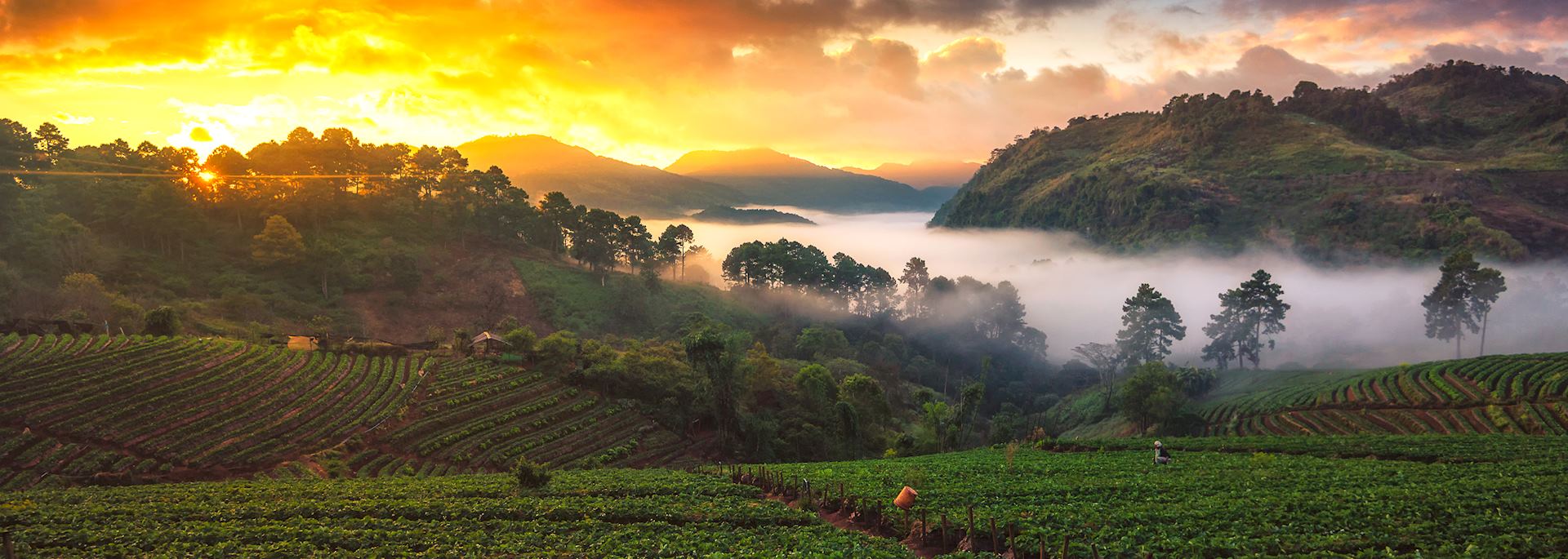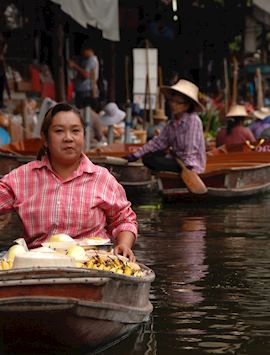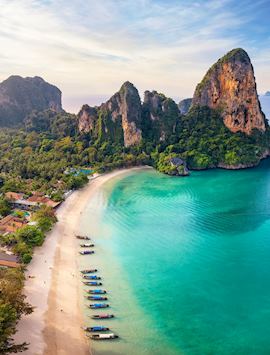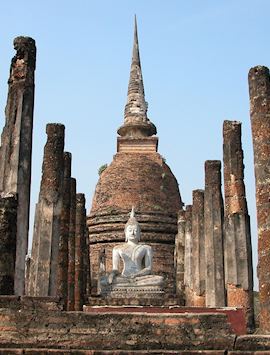By Thailand specialist David
It was love at first sight, when I first journeyed to Thailand in 2006. What struck me most was the contrast between fast-paced, high-rise Bangkok and the country that lies outside.
One minute you can be happily lost in Bangkok’s hustle and bustle. But you’ll encounter endless stretches of rich-green rice paddies in the provinces and, further north, a mountainous landscape inhabited by hill tribes. Thailand has its beach resorts but it also presents many opportunities to stray away from the beaten track.
Get local in Bangkok
Thailand’s capital has a list of big attractions — such as the Grand Palace and the reclining golden Buddha at Wat Pho — that most people want to make time for.
Travelling from site to site in an air-conditioned vehicle is the commonest way for visitors to get around. However, we’ve also developed a different style of tour that shows Bangkok’s highlights in an alternative light, by travelling around as the locals do.
You and your guide will take a water taxi, jump on a tuk-tuk and use the BTS Sky Train to explore while gaining a knowledge of how the locals get around.
One of the special parts of the tour for me was the way you arrive at Jim Thompson House (Thompson being the man who revived the Thai textile industry, and later mysteriously disappeared in Malaysia). His house — an old wooden colonial-style building — displays the vast collections of Southeast Asian art he amassed.
We were ferried there along a tiny backwater canal ('klongs' in Thai), to the rear entrance. I’d taken the same route hundreds of times before, but would never have known where to disembark if it wasn’t for this local knowledge.

Visit the local communities of Doi Angkhang
Dubbed as Little Switzerland, Doi Angkhang’s rolling hills and lush farming climate produce a vast array of fruit and vegetables. Close to the Burmese border, it’s worth hiring a bike to explore The Royal Project — a plantation set up by the King to educate villagers in the alternatives to opium farming. As well as taking in the sweet smell of roses, expect to enjoy a lot of strawberries, peaches and lychees.
You can experience off-the-beaten-track culture visiting the Phumanee hill tribes. You’ll witness daily life — the women preparing food, the men farming the land, cattle wandering around. Yes, the accommodation at the local guesthouse is a little basic, but for those who want that head-first cultural experience it’s a wonderful chance to see how a Thai tribe lives its daily life.

Seek out Chiang Mai’s ancient temples and colourful markets
Just an hour’s flight from Bangkok (or 12 hours on a sleeper train if you want to enjoy the changing landscapes as you journey north), and yet Thailand’s second largest city, Chiang Mai, couldn’t be more different from its big sister. As you arrive you’ll notice a lack of high-rise buildings, a laid-back pace and an old city that still maintains its authenticity.
One of my favourite things to do is visit the night market down by the river. Running through the night, it serves the most amazing street food. I always have to taste some satay — deliciously aromatic. The dishes contain a fusion of flavours influenced by Chiang Mai’s proximity to Myanmar and Laos, and the vast array of stalls give you the perfect opportunity to sample delicious and fragrant Northern Thai cuisine.

Relax on Thailand’s Andaman Coast
I’d choose the warm sands and crystal-clear waters around Krabi above all of Thailand’s beaches. The only thing that interrupts your hazy horizon view are the limestone karsts that jut out the ocean and the sandbanks that run between the hundreds of uninhabited islands.
Phang Nga Bay runs from Phuket to Krabi, an area fantastic for diving and snorkelling. A great way to explore is on a four island tour — allowing you to hop on and off different islands, enjoy a picnic lunch on a deserted beach and then return to your hotel in the afternoon.
The boutique-style Tubkaak Resort, just north of Krabi, offers luxurious beach-front rooms and pool villas — but its main draw is the beach view, one of best I’ve seen, looking out across the bay. The sun goes down behind the islands of Yao Yai and Koh Yao Noi as the shadows spread across the water, throwing purple and orange beams across the sky.

Cruise to Ayutthaya
The Ancient capital of Siam, Ayutthaya is a UNESCO World Heritage Site scattered with ancient temples similar in style to Angkor’s.
To appreciate fully the majesty of the city, I’d suggest heading up on an overnight cruise. The two-day trip on the Loy Pela Song, a six-berth converted rice barge, departs from Bangkok and journeys up the Chao Phraya River. It’s a great alternative to journeying by road and when you arrive the boat is moored overnight so you can admire the lighted temples while you dine on board.
It’s fun to tour the temple complexes the next day by jumping on and off tuk-tuks (locally known as Kermit tuk-tuks due to their colour and froggy noses).

Befriend an elephant
Elephants and Thailand go hand in hand, and conservation and educating visitors around it is the focus of an increasing number of elephant sanctuaries. Those we work with offer a genuine conservation experience, such as the Elephant Hills, located in Thailand’s oldest national park — Khao Sok — in the south of the country.
Elephant Hills has two tented camps set in the jungle, in the heart of the national park, yet conveniently close to some of Thailand’s best beaches.
The main camp allows you to see the elephants in their natural habitat. The emphasis is on learning how to care for the elephants (they aren’t ridden here). Visitors help to feed and bath them under the eye of the Mahouts who train them. The camp is a few hours’ travel from Phuket but it does mean you’ll encounter few visitors: just you and your fellow guests at the camp.
The second camp — and the highlight for me — is a floating village, in the centre of the Cheow Larn lake, a remote location an hour and a half from the main camp. There are just 20 luxury tents that float on the lake (which is safe to swim in and you can jump straight into the water from your tent), and a pontoon for meals. Each tent has its own kayak, which you can take out to explore the mangroves.
Each morning, you can look out through the mist to see limestone karsts jutting out from the jungle floor, while listening to the sound of gibbons echoing in the trees.

Trek through Khao Yai National Park
If you want to do some trekking but don’t have time to travel to Northern Thailand, Khao Yai National Park is located just 2.5 hours outside Bangkok. The uphill drive is exhilarating, but the park itself is mainly flat so you can explore at an easy pace.
Wild elephants roam inside the park. Sightings aren’t guaranteed, but I was lucky enough to see eight, as well as deer, gibbons and wild boar, last time I visited.
After a day’s trek, head back to your hotel, freshen up and then take a night safari. With a high-powered spotter torch and an open-top jeep, your guide will help you discover nocturnal creatures such as the gaur, the world’s largest bovine, and mouse deer, as well as the elephants.

Explore the Golden Triangle
The Golden Triangle is an area in the north of Thailand where Myanmar, Laos and Thailand converge. The chocolate-brown waters of the Mekong River forms the border. You can stand on the Thai side and see Laos to your right and Myanmar to the left.
As a place to stay, the Anantara Golden Triangle Hotel — with its three country views — is a real highlight. Mekong cruises depart from here and it’s a great entry/exit point if you’re travelling on to Laos, Vietnam or Cambodia.

Indulge in the flavours of Thai cuisine
You’ll experience delicious food wherever you travel in Thailand. From satay and spice to salads and sticky rice.
My favourite Thai dishes are Som Tam and Larb Gai. The former is shredded papaya with carrots and lime, which epitomises the sweet and sour contrasts of Thai cuisine. And the latter is a fragrant and healthy minced chicken dish created with chillies, lime and mint served with sticky rice.
A great way to experience different types of food and drinks is on a street food walking tour in Bangkok.

Discover Isaan
The Isaan Province, to the east of Bangkok, is an agricultural heartland that few travellers see. If you’re looking to escape off the beaten track you can explore the villages, rice paddies and farms by staying with a local family on a homestay. Or stay in one of the basic but authentic hotels in Ubon Ratchathani.
While you’re there, venture out to some of Thailand’s most remote temples — that I’ve only recently discovered. Many are so well-hidden that very few people have experienced their sights.

Visit the Bridge on the River Kwai
Built by the Japanese in World War II, the Bridge on the River Kwai is surprisingly quiet as it takes time to get there.
For that reason, I’d recommend an overnight stay. As well as visiting the bridge, this will allow you to head out to the surrounding Erawan National Park, where a seven-tiered waterfall froths and tumbles.
The accommodation is brilliantly quirky. The Float House sits above the River Kwai itself. Hire a bicycle and pedal around, taking in the local town, the World War II sights and the backdrop scenery.

Start planning your trip to Thailand
Start thinking about your experience. These itineraries are simply suggestions for how you could enjoy some of the same experiences as our specialists. They're just for inspiration, because your trip will be created around your particular tastes.
View All Tours in Thailand




